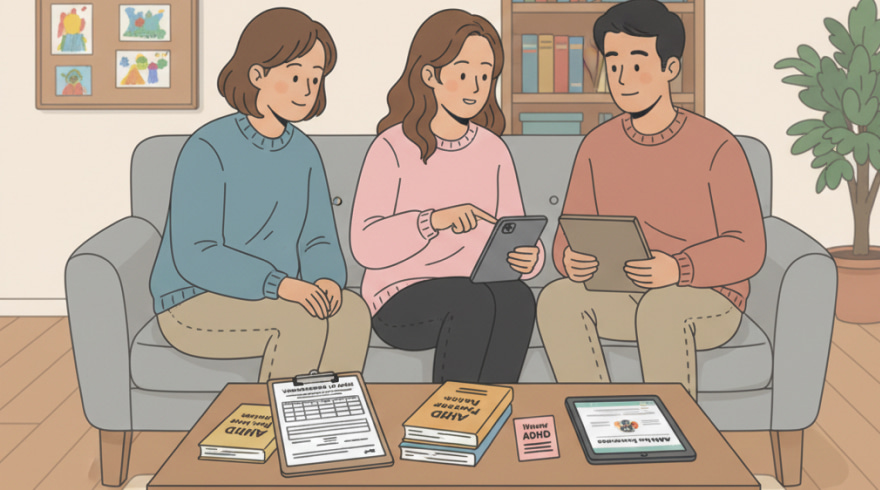Calm Confidence: A Parent’s Guide to Raising a Child With ADHD
- 30 October 2025

What ADHD Looks Like at Home and Why It Happens
Attention-deficit/hyperactivity disorder is a brain-based difference in how attention, motivation, and self-regulation operate. At home, this can look like time-blindness, intense emotions, restless energy, and difficulty shifting from preferred activities to necessary ones. None of this is a moral failing. It reflects lagging executive skills such as working memory, inhibitory control, and planning. When we see behavior through that lens, we can replace blame with practical support, environmental design, and teachable routines.
Children thrive when adults externalize expectations. Visuals, checklists, timers, and consistent cues offload the heavy cognitive work, turning “try harder” into “let’s make it easier to do the right thing.” Dopamine and novelty drive engagement, so small doses of fun, movement breaks, playful countdowns, or gamified chores, can transform battles into momentum. The goal is not perfection; it is progress that compounds over weeks and months, with scaffolds that gently fade as skills grow.
- Think “can’t yet,” not “won’t,” and co-create supports instead of escalating demands.
- Chunk tasks into bite-sized steps and preview transitions with clear, concrete language.
- Use movement as a tool: heavy work, quick sprints, or stretch breaks regulate bodies and minds.
- Make the invisible visible with picture schedules, color coding, and consistent placement of supplies.
- Celebrate effort loudly and often, because specific praise wires the habits you want to see again.
Over time, these approaches reduce friction, build trust, and give your child a reliable path to feel capable. With steadiness and empathy, home becomes the training ground for skills that generalize to classrooms, teams, and friendships.
Routines, Transitions, and Morning‑to‑bedtime Flow
Routines act like autopilot for busy families. They free up precious mental bandwidth, shrink decision fatigue, and give kids something predictable to lean on when emotions run high. Rather than chasing compliance, think about designing a path of least resistance: lay out clothes the night before, stash homework tools in a see-through caddy, and stack backpack, shoes, and water bottle by the door. Predictable anchors turn chaotic moments into repeatable sequences.
Start with predictable anchors, wake, meals, movement, homework, and sleep, then layer cues that a child can see and hear. Families often get traction by collecting small, teachable moves, and phrases like ADHD tips for parents resonate when they translate into steps the child can rehearse. Consider micro-transitions: a two-minute warning, a silly handshake to mark “all done,” and a snack plus water before homework. Build in choice where you can, such as the order of tasks, to increase buy-in and a sense of control.
- Use “first-then” language to pair a non-preferred task with a preferred activity.
- Post a morning checklist at eye level and point to it rather than repeating instructions.
- Adopt a consistent soundtrack for specific routines to create an auditory cue.
- Place friction reducers in the environment: duplicate chargers, pencil cups in every room, extra socks by the exit.
- Preview the day with a quick “three beats” plan: what’s first, what’s tricky, what’s fun.
The following quick-reference chart offers concrete cues and scripts that make common hotspots easier to navigate.
| Scenario | Helpful Cue | What to Say |
|---|---|---|
| Before school rush | Picture checklist by the door | “Check the list and tell me what’s next while I set the timer for two minutes.” |
| Homework start | Clear desk, single task on an index card | “We’re doing just this one step, then a stretch break, first pencils, then math row one.” |
| Screen time shutdown | Five-minute visual timer and transition song | “When the song ends, games pause and we move to water-snack, then shower.” |
| Bedtime wind‑down | Dim lights and the same three-book routine | “Book two starts after teeth; when book three ends, lights are off and stars on.” |
Positive Discipline, Motivation, and Emotional Coaching
Discipline and teaching are the same job with different tones. Kids learn best when adults stay calm, predictable, and specific. Instead of lengthy lectures, use short scripts and clear boundaries delivered with warmth. When missteps happen, lead with regulation: breathe together, label the feeling, and offer two simple choices that both move the situation forward. Consistency matters, but so does flexibility; match the strategy to the child’s energy, hunger, and sleep levels.
Motivation surges when tasks feel doable and success is visible. Swap “finish everything” for “start for five minutes” and celebrate a clean start. External rewards are scaffolds, not bribes; keep them small, immediate, and tied to effort, then fade as internal pride kicks in. Track wins publicly with a whiteboard or sticker grid and narrate what worked: “You paused, asked for help, and tried again, that’s perseverance.”
- Use “catch them doing right” praise that is specific, immediate, and frequent.
- Create a calm corner with sensory tools: putty, noise-reducing headphones, and a weighted lap pad.
- Teach repair scripts: “I was mad and shouted; I’m sorry. Can we redo that transition together?”
- Practice problem-solving with role-play when everyone is regulated, not in the heat of the moment.
- Replace “stop” commands with “do” directions that tell the child exactly what to do next.
When adults model self-regulation and structured choices, children internalize the rhythm of pause, plan, and proceed. Over time, that rhythm becomes a durable life skill.
Partnering with School and Building Skills That Last
Strong home–school collaboration turns isolated strategies into a coherent support plan. Teachers, counselors, and families can align accommodations so expectations are consistent across settings. Share evidence of what works at home, and ask for parallel systems in class: visual schedules, chunked assignments, and defined movement breaks. Clarity reduces anxiety for everyone, including the adults implementing the plan.
Start by identifying the highest-friction moments, warm‑ups, note-taking, or unstructured time, and match them with practical supports. When you translate guidance into classroom routines, expressions such as ADHD parenting tips become actionable checklists for both home and school. Request seating that limits distractions, keep spare supplies on hand, and use a communication notebook for quick daily wins. If needed, pursue 504 or IEP accommodations to formalize the help a student needs to access learning.
- Ask for clear rubrics, exemplars, and extended time for multi-step tasks.
- Advocate for movement breaks, alternative demonstration of mastery, and flexible deadlines.
- Use assistive tools: speech-to-text, text-to-speech, and graphic organizers for planning.
- Rehearse executive skills explicitly, backpack cleanouts, calendar checks, and weekly planning rituals.
- Schedule quick check-ins to adjust supports based on data, not hunches.
Skill building is cumulative. With aligned systems and consistent language, students experience more success reps, which strengthens confidence and independence.
Caring for the Caregiver and Sustaining Momentum
Parenting a neurodivergent child is meaningful and demanding, and your energy is the engine of the household. Sustainable care starts with your own sleep, connection, and boundaries. Carve out micro-rest: a ten-minute walk, a cup of tea in silence, or a text thread with someone who gets it. Choose one priority change at a time, and let the rest be “in progress” without guilt. Perfection is not a prerequisite for growth.
Systems reduce reactivity. Batch tasks on a weekly rhythm, automate refills and recurring purchases, and set alarms for the transitions adults forget too. Build a small support network: a trusted sitter, a neighbor who can swap playdates, and a therapist or coach to problem-solve thorny patterns. Celebrate small wins out loud at dinner, and name the strategies that made those wins possible so everyone knows what to repeat tomorrow.
- Keep a family “wins log” to notice progress that might otherwise vanish in the busy swirl.
- Use shared calendars and color codes so responsibilities are visible and equitable.
- Practice “good‑enough” routines during high-stress seasons, then refine when bandwidth returns.
- Protect one reliable point of joy each week to refill your tank.
When caregivers are resourced, kids feel safer, mornings run smoother, and setbacks become solvable puzzles rather than spirals. Your steadiness is a skill, and it is contagious.
FAQ: Parents’ Common Questions About ADHD
How do I tell the difference between can’t and won’t?
Look for patterns tied to executive load. If a child can do a task sometimes but not consistently, the issue is often context, energy, or clarity. Try shrinking the step, adding a visual, or prompting with a timer. When effort rises after you reduce friction, you’re seeing “can’t yet.” If a boundary is clear, the expectation is reasonable, and support is present, then calmly follow through with consistent, predictable consequences.
What’s the best way to handle big emotions and meltdowns?
Lead with regulation, not logic. Shorten language, lower your voice, and mirror the feeling: “You’re furious and want to keep playing.” Offer water and a simple choice that moves toward safety. When calm returns, debrief briefly: name the trigger, identify one earlier signal, and plan a tiny adjustment for next time. Practice coping skills when everyone’s regulated so they’re available under stress.
How can I improve homework time without power struggles?
Design a start ritual and keep the first slice of work tiny. Use a visual timer, single-task prompts, and a visible finish line with a short movement break. Remove unnecessary materials from the workspace to limit distractions. If focus fades, rotate subjects or formats, and end on a success to preserve momentum for tomorrow. Consistency beats intensity for building durable study habits.
Should we use rewards, and will they undermine intrinsic motivation?
Think of rewards as training wheels. Small, immediate reinforcers help the brain link effort to outcome, especially for tasks that lack built-in dopamine. Keep rewards specific to the behavior you want repeated, and gradually fade them while increasing acknowledgment of internal pride: “You stuck with a boring task for five minutes, serious grit.” Over time, mastery and autonomy take the wheel.
What school supports make the biggest difference?
Start with clarity and access. Ask for chunked instructions, exemplars, movement breaks, and a predictable routine for turning in work. Seat the student away from high-traffic zones, and allow assistive tech for reading and writing as needed. Align home and classroom cues so expectations feel familiar. Regular check-ins let the team refine supports based on what the data show, not guesswork.
Latest News
-
![Comprehensive Guide to the Parent-Based ADHD Rating Process]()
- 4 November, 2025
-
![A Complete Guide to the Vanderbilt Parent Rating for ADHD]()
- 3 November, 2025
-
![Parent-Rated ADHD Screening: A Comprehensive, Practical, and Trustworthy Guide]()
- 31 October, 2025



